by Nic Haygarth | 28/12/16 | Circular Head history, Story of the thylacine, Tasmanian high country history
A photo of two thylacine (Thylacinus cynocephalus) carcasses suspended from a hut in Waratah, Tasmania, has intrigued students of the animal’s demise. Who killed these tigers? Eric Guiler speculated that they might have been taken by a Waratah hunter John Cooney who collected two government thylacine bounties in 1901.[1]
In fact the photographer, Arthur Ernest Warde, was himself a hunter and future Woolnorth ‘tigerman’, and the photo probably depicts his own kills. The man in question was a wheeler and dealer who spent three decades in Tasmania, turning his hand to any useful practical skill—including photography and exploiting the fur trade. The terms of Warde’s stint at the Van Diemen’s Land Company’s (VDL Co’s) Woolnorth property in the years 1903–05 confirm that, far from being specialist thylacine killers, the so-called Woolnorth tigermen were simply regular hunter-stockmen who also took responsibility for managing snares set for thylacines at Green Point near latter-day Marrawah. Given this collision of photographer and tiger snarer, it is tantalising to wonder what tiger-related photos Warde took while working at Woolnorth that may still remain undiscovered in a family scrapbook, or which may have long since mouldered away in someone’s back shed, lost for all time.

Ernest Warde photo of Maori chiefs, 1998:P:0383, QVMAG
Warde’s early life remains as mysterious as his tiger photo. In Wellington, New Zealand in 1890 he married renowned whistler and music teacher Catherine Elizabeth Walker, née Dooley, the daughter of Zeehan shopkeeper Joseph Benjamin Dooley and his wife Annie Dooley.[2] The Wardes, both of whom were known by their middle name, appear to have been in Bendigo in 1891 and by 1893 had relocated to Inveresk, Launceston, where the photographer, ‘late of New Zealand’, presented images of Maori chiefs to the Queen Victoria Museum.[3] The couple’s first child, Winifred Warde, was born at Launceston in 1893.[4]
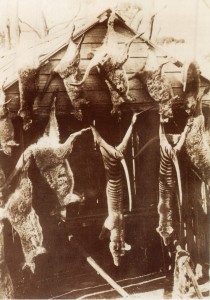
The Warde photo of the two thylacine carcasses, from Eric Guiler and Philippe Godard, Tasmanian tiger: a lesson to be learnt, p.129.
In 1896 the Wardes were in Devonport, in 1897 in Waratah, where second daughter Mabel was born.[5] Elizabeth taught music in both towns.[6] It was supposedly at Waratah that Warde took the intriguing photo, which shows two thylacine and eight wallaby carcasses hanging from the front of a building more closely resembling a woodshed than a hunting hut. The photo slightly pre-dates the era of the skinshed, the unique Tasmanian invention which revolutionised high country hunting by enabling hunters to dry large numbers of skins without leaving the high country. In fact, the photo does not show drying skins, but carcasses which are yet to be skinned. What is the purpose of the image? It is not the conventional trophy photo, which would pose the hunter with his trophy kill. Warde himself collected two thylacine bounties, ten months apart, in September 1900 and July 1901, while living at Waratah, where he probably learned to hunt.[7] Just as the bushman Thomas Bather Moore celebrated in verse the incident in which one of his dogs killed a ‘striped gentleman’, perhaps for Ernest Warde the novelty of killing a thylacine or two justified commemoration or memorialisation of the event with a photo. It is likely that he killed at least one of the thylacines in the photo, and afterwards submitted it for the government bounty.
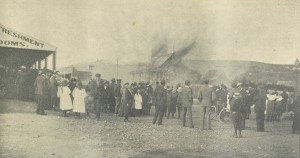
Warde’s Osborne Studio photo of the fire at ER Evans boot shop and house, Burnie.
From the Weekly Courier, 1 March 1902, p.17.
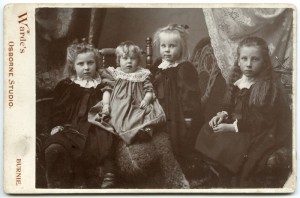
Warde’s Osborne Studio photo of EJ Wilson’s children, 1986:P:0045, QVMAG.
Warde was one of many to have practised photography in Waratah, and with the town’s population still growing, he would not be the last. However, in December 1901 a better photographic opportunity arose in a coastal centre, Burnie, when John Bishop Osborne decided to move on. Warde took over Osborne’s Burnie studio, while also operating a farm at Boat Harbour and advertising his and Elizabeth’s services as musicians.[8] In 1902, while Elizabeth was busy producing the couple’s third child, Francis Harold Warde, photos credited to Warde and to Warde’s Osborne Studio photos appeared in the Weekly Courier and Tasmanian Mail newspapers.[9]
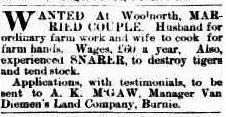
The tigerman job advertised, North Western Advocate and the Emu Bay Times, 22 May 1903, p.3.
Warde appears to have made the acquaintance of VDL Co agent AK McGaw while supplying photos to the company. The photography business must not have been lucrative, as in May 1903 he agreed to replace the gaoled George Wainwright as the Mount Cameron West tigerman.[10] Warde’s contract as ‘Snarer’ shows him to be a general stockman and farm hand engaged for the Mount Cameron West run, with the killing of ‘vermin’ (that is, all marsupials) his primary duty:
‘It is hereby agreed that the Snarer shall proceed to Mount Cameron Woolnorth … and shall devote his time to the destruction of Tasmanian Tigers, Devils and other vermin and in addition thereto shall tend stock depasturing on the Mount Cameron Studland Bay, and Swan Bay runs, also effect any necessary repairs to fences and shall immediately report any serious damage to fences or any mixing of stock to the Overseer & shall assist to muster stock on any of the above runs whenever required to do so & generally to protect the Company’s interests shall also prepare meals for stockmen when engaged on the Mount Cameron Run’.
The pay was £20 plus rations (meat, flour, potatoes, sugar, tea, salt, with a cow given him for milk) with the snarer providing his own horse.[11] A butter churn was later provided, and farm manager James Norton Smith added that ‘when he wants a change he can catch plenty of crayfish’.[12] No rent was paid for the Mount Cameron West Hut, and the former company reward of £1 per thylacine still applied. In addition, the VDL Co agreed to supply the snarer ‘with hemp and copper wire for the manufacture of tiger snares only (the Snarer supplying such materials as he may require for Kangaroo or Wallaby snares)’.[13] That is, the necker snares used to catch thylacines were stronger than those used to catch wallabies and pademelons. It was the same deal as for his predecessors: the company supplied a small wage and rations, encouraging the stockman-hunter to protect his flock by killing thylacines and keep the grass down by killing other marsupials. In July 1904 Warde advertised in the newspaper for an ‘opossum dog’, which he was willing to exchange for a ‘splendid kangaroo dog’. He knew that the best money was in brush possum furs.[14]
Warde was the last stockman-hunter based at Mount Cameron West. Nearing the close of 1904 he was also trying to ‘get a good line of snares down from the Welcome [?] forest into the back of the Studland bay knolls’, which would give him ‘a splendid tiger break …’[15] However, he had probably already landed the last of his twelve thylacines for the company. In February 1905 the Mount Cameron West Hut was burnt down, Warde’s family escaping the flames late at night in the breadwinner’s absence.[16] That the hut was not replaced for years confirms that the thylacine problem, real or perceived, had abated.[17]
After leaving Mount Cameron West, Ward ditched the ‘e’ from the end of his surname and complemented the Boat Harbour farm with a general store. The Wardes remained there until in 1923 they sold up their store to Hamilton Brothers of Myalla and relocated to New Zealand, where A Ernest Warde reattached his ‘e’ and reinvented himself firstly as an Otago real estate agent, working for his father-in-law, then as an Auckland used car salesman.[18] Elizabeth Warde disappeared from the picture and, appropriately, Ernest wound back his personal odometer to 49 years when in 1932 he took his new 33-year-old bride Mary Winifred Tremewan to see England and America.[19] The new marriage ended when the couple was living in Sydney in the mid-1940s.[20] Warde’s death certificate, in July 1954, described him as an ‘investor’. In truth, he was a trans-Tasman jack-of-all-trades who happened to be the last of the Woolnorth tigermen.[21]
[1] Eric Guiler and Philippe Godard, Tasmanian Tiger: a lesson to be learnt, Abrolhos Publishing, Perth, 1998, p.129. Cooney’s bounty payment was no.249, 19 June 1901 (2 adults, ’11 June’), LSD247/1/ 2 (Tasmanian Archive and Heritage Office [hereafter TAHO]).
[2] For her prowess as a whistler, see ‘Current topics’, Launceston Examiner, 15 January 1894, p.5; ‘Burston Relief Concert’, Daily Telegraph, 16 January 1894, p.3 and ‘Entertainment at the Don’, North West Post, 21 April 1894, p.4. Elizabeth Walker is the mother’s name given on the couple’s three children’s birth certificates. On the 1903 Electoral Roll her name is given as Catherine Elizabeth Warde.
[3] ‘Australian Juvenile Industrial Exhibition’, Ballarat Star, 26 May 1891, p.4; ‘The Museum’, Launceston Examiner, 23 December 1893, p.3.
[4] She was born 31 August 1893, birth registration no.606/1893, Launceston.
[5] In 1896 E Warde of West Devonport advertised to sell a camera, lens and portrait stand (advert, Mercury, 23 May 1896, p.4). In 1897 the Wardes featured in a Waratah dance (‘Plain and Fancy Dress Dance’, Launceston Examiner, 9 October 1897, p.9). Mabel Warde’s birth was registered as no. 2760/1898, Waratah.
[6] Advert, North Western Advocate and the Emu Bay Times, 30 January 1902, p.3.
[7]; Bounties no.293, 18 September 1900 (’11 September’); and no.305, 12 July 1901, LSD247/1/2 (TAHO).
[8] See advert, North Western Advocate and the Emu Bay Times, 6 December 1901, p.4; ‘Table Cape’, North Western Advocate and the Emu Bay Times, 19 November 1901, p.2. John Bishop Osborne, the former Hobart photographer, had been on the move every few years since setting up at Zeehan in 1890. Osborne moved to Penguin, and he would end his days in Longford, where he lived 1921–34. Ernest and Elizabeth Warde advertised that they were available to supply music to parties and balls, while Elizabeth also sought piano, organ and dance students (advert, North Western Advocate and the Emu Bay Times, 30 January 1902, p.3).
[9] Francis Harold Warde was born at Alexander Street, Burnie, on 17 December 1902 (registration no. 2061/1903). Catherine Elizabeth Warde and Ernest Warde were listed at Burnie on the 1903 Electoral Roll.
[10] The new operator of the Osborne Studio was Mr Touzeau of Melba Studio, Melbourne (advert, North Western Advocate and the Emu Bay Times, 27 June 1903, p.1). Warde held a furniture sale at his Alexander Street, Burnie, residence in June 1903 (‘Burnie’, North Western Advocate and the Emu Bay Times, 13 June 1903, p.3) and advertised for a ‘strong quiet buggy Horse and good double-seated Buggy (tray-seated preferred …’ (advert, North Western Advocate and the Emu Bay Times, 8 June 1903, p.3).
[11] For Warde’s proposed rations, see James Norton Smith to AK McGaw, 4 June 1903, VDL22/1/34 (TAHO).
[12] James Norton Smith to AK McGaw, 4 June 1903; Ernest Warde to AK McGaw, 7 October 1903, VDL22/1/34 (TAHO).
[13] Agreement between the VDL Co and Ernest Warde, 29 May 1903, VDL20/1/1 (TAHO).
[14] Advert, North West Advocate and the Emu Bay Times, 26 July 1904, p.3.
[15] E Warde to AK McGaw, 22 December 1904, VDL22/1/35 (TAHO).
[16] ‘Marrawah’, North West Advocate and the Emu Bay Times, 11 February 1905, p.2.
[17] Woolnorth farm journal, 3 February 1905, VDL277/1/32 (TAHO).
[18] ‘Boat Harbor’, Advocate, 31 January 1923, p.4; ‘Bankruptcy’, Auckland Star, 27 September 1929, p.9.
[19] Did Elizabeth Warde die or did the couple divorce? No record of her was found. According to their marriage certificate (registration no.8401/1929), Mary Winifred Tremewan was born in New Zealand in October 1898. For their ten-month English and American holiday, see ‘The social round’, Auckland Star, 6 January 1933, p.9 and UK Incoming Passenger Lists, 1878–1960. They sailed from Sydney to London on the Ormonde.
[20] Record no.1208/1944, Western Sydney Records Centre, Kingswood, NSW.
[21] Warde was not the last man to kill thylacines at Woolnorth, but the last in a long line of hunter-stockmen appointed specifically to Mount Cameron West to look after stock and manage the thylacine snares at Green Point.
by Nic Haygarth | 17/12/16 | Circular Head history, Story of the thylacine
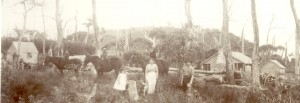
The Wainwrights at Mount Cameron West (now returned to the Aboriginal people, as Preminghana) during the late 1890s. Sunday best is adopted for the photographer. The girl standing at front beside her parents Matilda and George is probably May, the boys on horseback are probably George, Dick and Harry. Photo courtesy of Kath Medwin.
In 1889 Van Diemen’s Land Company (VDL Co) local agent James Norton Smith advertised for ‘a trustworthy man to snare tigers [thylacines or Tasmanian tigers], kangaroo, wallaby and other vermin at Woolnorth’, the company’s large grazing property at Cape Grim. The annual wage was £30 plus rations and a £1 bounty for each thylacine killed.[1] Applications came from Tasmanian centres as far afield as Branxholm in the north-east and New Norfolk in the south. One, written on behalf of her husband, came from Rachel Nichols of Campbell Town. She was the mother of then eleven-year-old Ethelbert (Bert) Nichols, the future hunter, Overland Track cutter, highland guide and Lake St Clair Reserve ranger.[2]
However, none of these applicants got the job. The man chosen as ‘tigerman’, as the position was known within the VDL Co, was George Wainwright senior, who arrived ‘under a cloud’ as George Wilson and departed in 1903 when convicted of receiving stolen skins.[3] Was he a relation of Woolnorth overseer James Wilson, or how was he selected for the job?[4] And what was a tigerman anyway?
George Wainwright was born in Launceston in 1864, and seems to have a not untypical upbringing for the poorly educated child of an ex-convict father, featuring family breakdown, petty crime, shiftlessness and suggestions of poverty.[5] As a young adult he measured only 162 cm (5 foot 3 inches), with a dark complexion and dark curly hair. The scar under his chin may have the result of rough times on the streets of Launceston.[6] Food may have been scarce. At thirteen he faced court with another boy on a charge of stealing apples (the case was dismissed for lack of evidence).[7] In 1883, his employer, Launceston butcher Richard Powell, had the nineteen-year-old arrested on warrant (that is, in absentia) on a charge of breaching the Master and Servant Act.[8] He had run off to Sydney, describing himself as a cook.[9]
George had returned to Launceston by October of that year, when his mother, now known as ‘Mrs T Barrett’ (née Caroline Hinds or Haynes or Hyams), ran a public notice instructing clergymen not to marry her son to anyone, he being under age.[10] Presumably George had Matilda Maria Carey (1863–1941)—or her pregnancy—in mind, because the couple were soon united, and soon separated.[11] In 1885 Matilda prosecuted George for deserting her and George junior, having not sent her any money for six months. It was revealed in court in Melbourne that George had recently been a grocer’s assistant, but now was working in a Brunswick (Melbourne) brick yard. Matilda Wainwright was then living with her father-in-law William Wainwright in Launceston. She claimed he showed her little sympathy, having sold all her furniture and told her to seek a living for herself. George Wainwright was freed on agreeing to pay her 10 shillings per week.[12]
Interestingly, in Victoria he was known to police as George Brown, ‘alias Wainwright’.[13] Presumably he returned to Launceston sometime between 1885 and 1889—and changed his name to George Wilson! He may have been the George Wilson who was in Beaconsfield in 1886 and 1887.[14] Perhaps he became a protégé of James Wilson, the Woolnorth overseer, and perhaps that man’s intervention secured Wainwright/Brown/Wilson the tigerman job at Woolnorth. James Wilson had coined the term ‘tigerman’ to describe the Mount Cameron West shepherds in the period 1871–1905. Convinced that thylacines were killing their sheep, the VDL Co gave the Mount Cameron West man the additional job of maintaining a line of snares across a narrow neck of land at Green Point, which was believed to be the predator’s principal access point to Woolnorth. Otherwise, the tigermen were actually standard stockmen-hunters, charged with guarding sheep and destroying competitors for the grass.
George Wilson and his family originally occupied a one-room hut at Mount Cameron West. In 1893 George Wainwright, as he was now known again, apparently told a visitor that he received £2-10 for each thylacine killed—£1 from the VDL Co, £1 from the government and 10 shillings for the skin. In the years 1888–1909 the Tasmanian government paid a bounty on every thylacine carcass submitted to police. However, nobody by the name of Wainwright ever collected a government bounty: in fact only two VDL Co tigermen, Arthur Nicholls and Ernest Warde, personally collected government bounties while working for the company.[15] The thylacine carcasses appear to have been sold through intermediaries, chiefly Stanley merchants Charles Tasman (CT) Ford (1891–99) and (after Ford’s death) William B (WB) Collins (1900–06). Ford, who also drove cattle down the West Coast to Zeehan and bought VDL Co stock, was a regular visitor to Woolnorth.[16]
In 1893 Wainwright had about 60 springer snares set for wallaby, pademelon and brush possum.[17] Ringtails were the dubious beneficiary of technological change, as the commercial manufacture of acetylene or carbide during the 1890s revolutionised ‘spotlighting’. Using an acetylene lamp to spotlight nocturnal animals was a vast improvement on the traditional method of shooting by moonlight, since some animals, especially the ringtail possum and ‘native cat’, were ‘hypnotised’ by the lamp, remaining rooted to the spot. It was not the ideal hunting technique for a grazing run, however, let alone for a solitary shepherd. Usually, two men worked together, one ‘spotting’ the animals with the acetylene lamp, the other shooting them. The lamps which shooters used frightened stock, and sometimes shooters’ dogs ran amok with grazing sheep. More significantly for the hunter, shooting the animal in any other part but the head damaged its pelt. Acetylene fumes were also unpleasant for the hunter, and the battery sometimes gave him an unexpected ‘charge’.
More money was available for a living tiger than a dead one. By Wainwright’s time, thylacines were in demand from zoos. In 1892 James Denny caught one alive at the Surrey Hills and sent it to the Zoological Gardens in Melbourne.[18] In 1896 CT Ford was asked to procure live tigers for a circus. Wainwright obliged by capturing a thylacine alive and sending it into Stanley, where there was ‘a little excitement … to see “the tiger”’ before it was shipped to Sydney.[19] This thylacine capture does not appear in the extant Woolnorth farm journal record (the journal for 1896 is missing) or in any other surviving official records for Woolnorth. Since the animal was not killed, Wainwright received no VDL Co or government reward for it.
In 1897–98 a new hut was built for George and Matilda at Mount Cameron. They would need it. Six children—George, Alf, Dick, May, Harry, Gertrude and Robert—gave them plenty to worry about in such an isolated place. If that was not enough, Matilda was reportedly ‘very ill’ in July 1893 and ‘badly hurt’ in January 1894, while in May 1900 Woolnorth overseer W Pinkard had to fetch medicine for her from Stanley.[20]
By 1900 George and Dick were already showing their prowess as tiger snarers, and one of the Wainwright boys was digging potatoes.[21] With their father sometimes helping out elsewhere on the property, fetching cattle from Ridgley or a stockman from Trefoil Island, the children quickly developed a range of skills which ensured that they could work on the land independently.[22]
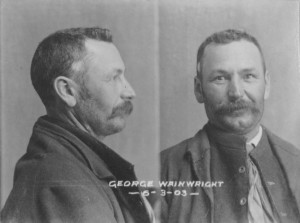
George Wainwright’s mugshot, 1903. Courtesy of TAHO.
Wainwright’s imprisonment in 1903 gave them that opportunity. The story of his crime of receiving 298 wallaby, 298 pademelon, 17 tiger cat, 2 domestic cat and 10 brush possum skins stolen from William Charles Wells contains insight into hunting at Mount Cameron West and on Woolnorth generally. Wells was caretaker (hunter-stockman) for a farm at Green Point south of Woolnorth, near where the VDL Co arranged its snares. The owner of the property, Thomas John King, had stayed with Wainwright in the Mount Cameron Hut in July 1902 after fetching the skins from the farm. The skins disappeared overnight after being left outside the hut in a cart. Suspicion fell on Wainwright not only because his was the only hut in the area but because he had previously tried to buy the skins at a price which was refused. Police alleged that in September Matilda Wainwright drove a buggy containing the skins to the port at Montagu to be loaded on the ketch Ariel.[23] It was now close season, so Wainwright wrote telling Stanley storekeeper WB Collins that he was sending down some out-of-season skins and suggesting that he ask the police to let them pass. Wells claimed to have identified 23 of his stolen skins in Collins’ store.[24] Proof that Wainwright was guilty centred on Wells’ identification of an unusually light skin among those Wainwright had sent to market. A search conducted among the skins of three Launceston skin merchants, Lees, Sidebottom and Gardner, revealed only three or four skins matching the one identified by Wells, confirming the distinctiveness of the skin and strengthening the case against Wainwright.[25]
Launceston merchant Robert Gardner testified that he had known Wainwright for 25 years, having employed him when he (Wainwright) was a boy, and that he had done business with him for several years, finding him straightforward and honest. He had bought wallaby skins from Wainwright regularly.[26] Despite this testimonial, Wainwright was given a twelve-month sentence for receiving stolen property. Thirty-nine years old, he died in the Hobart Gaol of heart failure prompted by acute pneumonia only four months into that sentence.[27]
Today a relatively young man’s death in custody would provoke an inquest. However, the harshness of Wainwright’s demise seems in keeping with the harshness of his sentence and the general torpor of working people’s lives more than a century ago. George must have done something right as a hunter and provider, because he left wife Matilda £305—more than ten times his annual stockman’s wage.[28]
Charged with nothing, Matilda Wainwright stayed on as cook at Woolnorth, although only because no one else could be found for the job. ‘I would have preferred anyone else rather than Mrs Wainwright’, new VDL Co agent AK McGaw lamented, ‘and now that she is there I am not altogether satisfied that her influence is for the best. Of course I find her appointment does not answer I will have no hesitation in terminating it’.[29] McGaw had advertised for a married couple to replace the Wainwrights.[30] He effectively got one when the widowed Matilda married the new overseer, Thomas Lovell, while her sons, good workmen, also had a future at Woolnorth. As a woman and mother, remarriage was her only option anyway. George Wainwright junior would carve out his own long career as a VDL Co stockman.
[1] ‘Wanted, at Woolnorth’, Daily Telegraph, 9 August 1889, p.1.
[2] Rachel Nichols to James Norton Smith, 8 August 1889, VDL22/1/19 (Tasmanian Archives and Heritage Office [afterwards TAHO]).
[3] AW McGaw, Outward Despatch no.16, 1 June 1903, p.151, VDL7/1/13 (TAHO); ‘Death of a prisoner’, Mercury, 15 July 1903, supplement p.6.
[4] On the bottom of J Lowe’s application for the job is written in pencil ‘Geo Wilson also’. Everett was the reserve choice: on the back of his application is written ‘If man, at present engaged—not successful will write JL again’. See J Lowe application 9 August 1889 and J Everett application, 19 August 1889, VDL22/1/19 (TAHO).
[5] For William Wainwright (1810–87), see conduct record, CON33-1-90, TAHO website, http://search.archives.tas.gov.au/ImageViewer/image_viewer.htm?CON33-1-90,207,205,F,60, accessed 17 December 2016.
[6] ‘Miscellaneous information’, Victoria Police Gazette, 19 August 1885, p.232.
[7] Birth registration 60/1864, Launceston; ‘Police Court’, Cornwall Chronicle, 7 February 1877, p.3.
[8] ‘Launceston Police Court’, Tasmanian, 22 April 1882, p.432; ‘Launceston Police Court’, Launceston Examiner, 7 February 1883, p.3.
[9] He arrived in Sydney from Launceston on the Esk, 9 February 1883, New South Wales, Australia, Unassisted Passenger Lists, 1826–1922.
[10] Advert, Launceston Examiner, 31 October 1883, p.1.
[11] Marriage registration 677/1883, Launceston. They married 7 November 1883, George William Wainwright was born seven months later, on 12 June 1884, birth registration 371/1884, Launceston. Matilda Maria Carey was born in Launceston, 22 December 1863, registration 23/1864, Launceston.
[12] ‘Wife desertion’, Launceston Examiner, 29 August 1885, p.2.
[13] ‘Miscellaneous information’, Victoria Police Gazette, 19 August 1885, p.232.
[14] ‘Beaconsfield’, Daily Telegraph, 29 May 1886, p.3; ‘Beaconsfield’, Launceston Examiner, 15 January 1887, p.12.
[15] Nicholls: bounties no.289, 14 January 1889, p.127; and no.126, 29 April 1889, p.133, LSD247/1/1. Warde: bounty no.190, 20 October 1904, p.325, LSD247/1/2 (TAHO).
[16] James Wilson to JW Norton Smith, 8 April 1879, VDL22/1/7 (TAHO).
[17] Austin Allom, ‘A trip to the west coast’, Daily Telegraph, 19 August 1893, p.7.
[18] ‘Current topics’, Launceston Examiner, 17 September 1892, p.2.
[19] ‘Circular Head notes’, Wellington Times and Agricultural and Mining Gazette, 25 June 1896, p.2.
[20] Woolnorth Farm Journal, 10 July 1893, VDL277/1/20; 22 January 1894, VDL277/1/21; and 7 May 1900, VDL277/1/25 (TAHO).
[21] Woolnorth Farm Journal, 13 and 14 June, 7 May 1900, VDL277/1/25 (TAHO).
[22] Woolnorth Farm Journal, 22 September 1898, VDL277/1/24; 16 January and 5 March 1899, VDL277/1/25 (TAHO).
[23] ‘Supreme Court’, North Western Advocate and the Emu Bay Times, 14 November 1902, p.2.
[24] ‘Supreme Court’, Mercury, 15 November 1902, p.3.
[25] ‘The Wainwright case’, Examiner, 28 February 1903, p.6.
[26] ‘The Wainwright case’, Examiner, 27 February 1903, p.6.
[27] ‘Death of a prisoner’, Examiner, 15 July 1903, p.6.
[28] ‘Testamentary’, Mercury, 20 October 1903, p.4.
[29] AK McGaw to VDL Co Board of Directors, no.38, 2 November 1903, p.313, VDL7/1/13 (TAHO).
[30] Advert, Examiner 20 May 1903, supplement p.8.







